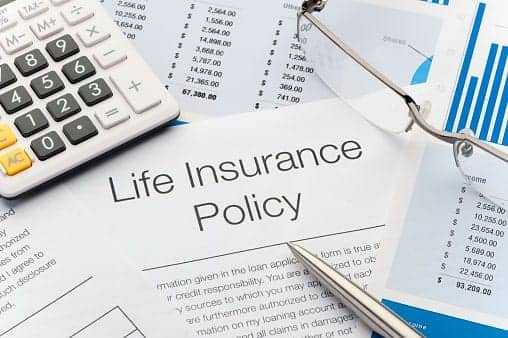- 1. Buy young.
- 2. Match your term to your timeframe.
- 3. Consider layering term policies.
- 4. Shop around.
- 5. Improve your health.
- 6. Quit smoking.
- 7. Improve your driving record.
- 8. Don't go for guaranteed issue if you can pass the medical exam.
- 9. Show how you're controlling any health conditions you have.
- 10. Look into extra coverage at work.
- 11. Check with associations.
- 12. Pay automatically and annually.
1. Buy young.
Your age has a major impact on life insurance rates. The younger you are when you buy the coverage, the lower your premiums.
For example, a 25-year-old non-smoking male can buy a $500,000 20-year term policy for an average cost of $442 per year. A 45-year-old man pays an average of $1,072 per year for the same coverage. At age 55, that same policy costs $2,620 a year.
As you get older, you're more likely to develop health conditions that prevent you from qualifying for the lowest premiums. Consider buying life insurance as soon as anyone depends on you financially.
Be careful of your timing within the year. Some insurers boost premiums to the next age on your birthday, but others use the "age nearest birthday" method and round your age up or down to the nearest birthday by six months.
2. Match your term to your timeframe.
You can buy term insurance that keeps premiums level for a fixed amount of time, such as 10, 20 or 30 years. The shorter the time frame, the lower the premiums. But you don't want the policy to expire while you still need coverage.
Think carefully about how long you need the insurance -- whether it's until your kids are grown, your house is paid off or you retire and your spouse can receive a pension death benefit, for example.
Consider buying a term policy that can convert to permanent coverage without new medical underwriting if your insurance needs change. Some policies will let you convert to permanent coverage within a certain number of years or before you reach an age cut-off.
3. Consider layering term policies.
You may require the most insurance when your kids are young and need support for decades. You may not need as much coverage as they get older, your savings grow and you get closer to retirement. However, you may still want to have some insurance at that point.
Consider layering term policies so you have the most coverage when they're young and less as they get older. That may be getting a 20-year term policy for most of your coverage and buying a smaller 30-year term policy, so you'll still have some coverage for those last 10 years.
Review your insurance needs every few years or after major life changes -- such as if you have another child, you buy a new house or your kids graduate from college -- to make sure you still have the right amount of coverage.
4. Shop around.
Term life insurance is a competitive business. Rates can vary a lot by insurer depending on who they're trying to attract at the time. And it's particularly important to shop around if you have any medical conditions because insurers can have very different standards.
"Companies vary in how they view medical information and how it fits in with their objectives and corporate goals," says Robert Gleeson, American Council of Life Insurers' medical consultant.
For example, some insurers may focus on providing coverage to people who had cancer in the past but meet specific medical criteria now.
Provide as much information about your medical history and other risk factors upfront so your quotes will be as accurate as possible. The insurer with the best deal for the healthiest people may not have the lowest rates for people with health issues.
Use our life insurance calculator to figure out how much coverage you need.
5. Improve your health.
Term insurers generally have several rate classes, with the lowest premiums (preferred or super-preferred rates) for people with the best health. Not only do they look at your medical history, but your rate can also depend on:
- Height/weight and body mass index
- Cholesterol level
- Blood pressure
- Other health factors
Improving those readings can help you qualify for a better rate.
If you already have a policy, you may be able to get the rate reduced -- or find a lower-priced policy -- if your health improves for a certain amount of time.
6. Quit smoking.
Smoking has a significant impact on mortality and insurance premiums. Premiums for smokers can be two or three times higher than they are for nonsmokers.
Insurers generally check for evidence of nicotine in your bloodstream during your medical exam.
But insurers have different definitions of smoking and different time periods for reducing your rate after you quit, so it's important to compare prices from several companies.
Find out more about how smoking affects life insurance rates .
7. Improve your driving record.
Your driving record can also affect your insurance premiums, especially if you've had major issues.
"It is common for insurers to look at your motor vehicle record," says Joel Jones, vice president and chief underwriter for Mutual Trust Life Insurance in Oak Brook, Ill., and a Society of Actuaries volunteer. "Generally speaking, minor vehicle infractions aren't considered significant, but major traffic violations are generally taken into account."
Your mortality risk can be higher if you've had DUI or reckless driving charges. Find out how long the information will stay on your driving record.
8. Don't go for guaranteed issue if you can pass the medical exam.
It may seem easy to get a policy with an insurer that doesn't ask any medical questions or check your doctor's records or require a medical exam.
But these guaranteed issue policies generally assume that the people will have medical issues. They usually charge more than a healthy person would pay for a fully underwritten policy.
Taking the extra time to go through medical underwriting upfront can save you money in premiums for years.
9. Show how you're controlling any health conditions you have.
Many insurers now cover people with medical issues that may have caused them to be rejected in the past, such as Hepatitis C, heart attacks and certain kinds of cancer.
However, insurers seek more information about the condition before deciding whether or not to issue a policy and how much to charge. You may get better rates depending on the diagnosis, timing and treatment, especially if you can show how well you've managed your condition.
"Being on top of your health care is more likely to help you," says Gleeson.
10. Look into extra coverage at work.
Many employers offer group life insurance as an employee benefit, often covering one or two times your annual salary. You may not have to pay premiums for this coverage. Some employers also let you buy additional life insurance at group rates, which you can take with you even after you stop working there.
Group coverage can help, but it isn’t likely enough to meet all of your needs. Also, coverage is usually connected to employment, so you lose it when you leave the job. However, group coverage can serve as supplemental life insurance to an individual policy.
11. Check with associations.
You may also qualify for a group discount on life insurance through alumni organizations, trade associations or other affinity groups.
Compare the rates to buying coverage on your own. You may get a better deal with an individual policy if you're in good health.
12. Pay automatically and annually.
Some insurers offer a discount if you pay premiums automatically from your credit card or bank account and if you pay your bill in full for the year rather than having monthly or quarterly billing.
Finding the cheapest term life insurance takes a little time. It's also important to choose a company you trust, so make sure that low rate is backed by a good reputation for true peace of mind.







